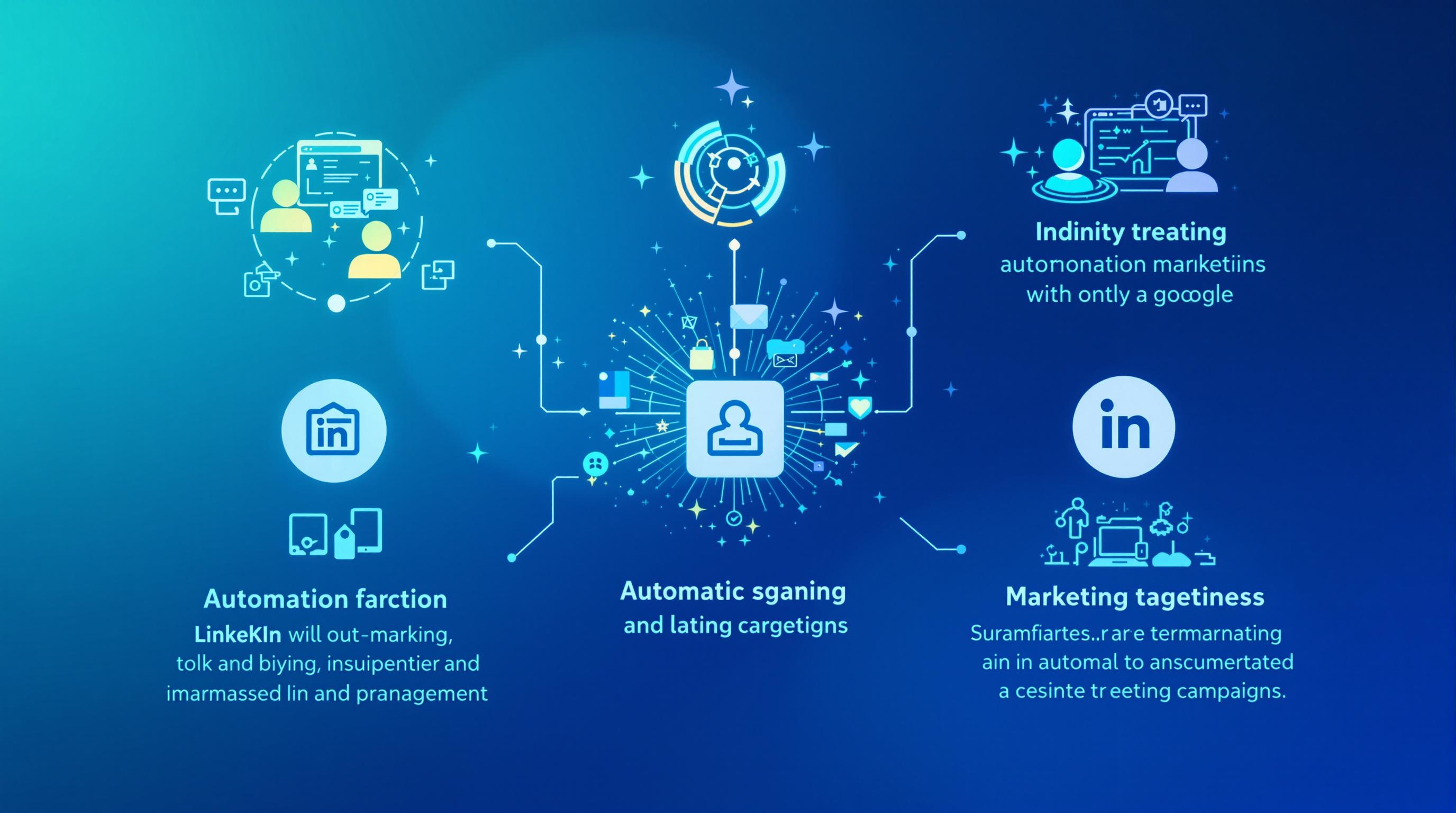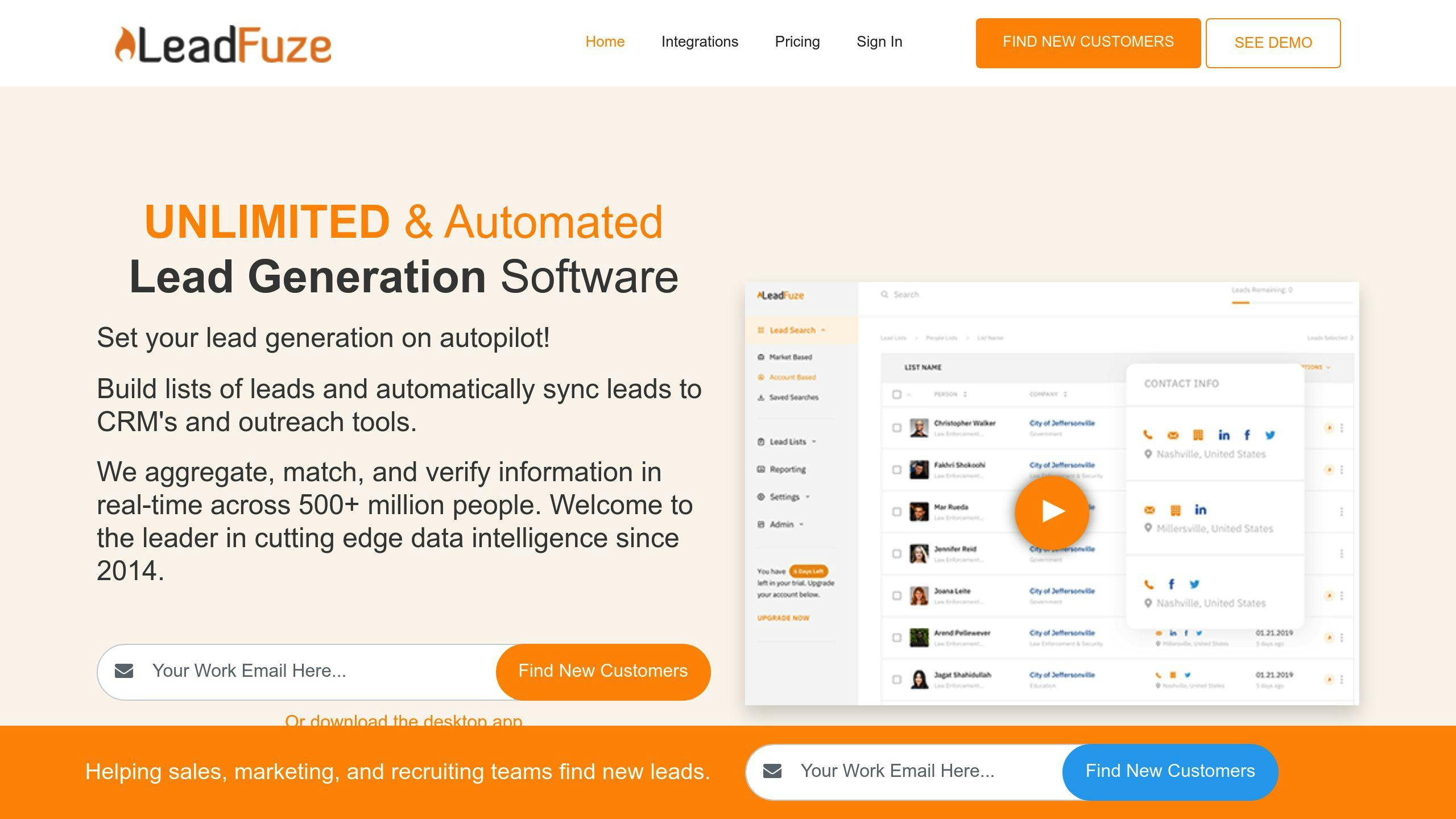Top 5 LinkedIn Segmentation Tools

Top 5 LinkedIn Segmentation Tools
Finding the right audience on LinkedIn can make or break your marketing campaigns. To simplify this, we’ve reviewed 27 tools and identified the top 5 LinkedIn segmentation tools to help you segment and target effectively. These tools excel in filtering, automation, and CRM integration to refine your audience and boost results.
Quick Overview of the Top 5 Tools:
- LinkedIn Sales Navigator: Advanced filters for job titles, industries, and engagement activity; integrates seamlessly with CRMs.
- Expandi: Cloud-based tool with smart automation, scraping, and campaign management features.
- Dux-Soup: Chrome extension offering profile scraping and basic segmentation for smaller teams.
- Phantombuster: Cloud-based platform with advanced automation and CRM sync for scaling campaigns.
- LeadFuze: AI-powered segmentation with multi-channel targeting and detailed analytics.
Quick Comparison Table:
| Tool | Key Features | Best For | Price Range |
|---|---|---|---|
| LinkedIn Sales Navigator | Advanced filters, CRM sync | Precise targeting | $79.99+/month |
| Expandi | Automation, scraping, analytics | Scaling outreach | $99+/month |
| Dux-Soup | Profile scraping, basic filters | Small teams | $15+/month |
| Phantombuster | Custom workflows, data exports | Advanced automation | $59+/month |
| LeadFuze | AI filtering, multi-channel sync | B2B lead generation | $132.30+/month |
Each tool offers unique strengths, so choose based on your goals, budget, and integration needs. Want more insights? Keep reading for detailed breakdowns of each tool and how they can fit into your workflow.
Best LinkedIn + Sales Navigator Scraper 2024 - Extract Data And Automate Tasks
1. LinkedIn Sales Navigator

LinkedIn Sales Navigator is a powerful tool for segmentation, offering deep integration with LinkedIn’s professional data. It’s specifically designed to help businesses identify and connect with the right prospects.
This tool provides advanced segmentation options with over 413 industry categories. Its filters allow users to target leads based on:
- Company details: Size, revenue, headcount, and growth rate
- Individual profiles: Job titles, seniority levels, and specific skills
- Engagement activity: Recent posts and mentions in the news
- Location: Multiple postal codes and regions
Sales Navigator also keeps track of prospects who have been active in the last 30 days or featured in news articles within the past 90 days. This ensures you focus on professionals who are currently engaged and relevant.
Another standout feature is its ability to sync with major CRMs. This integration helps teams combine LinkedIn’s data with their existing customer databases, streamlining segmentation and keeping all information in one place.
Here’s a quick look at its key features:
| Feature | Benefit |
|---|---|
| Advanced Filters | Helps pinpoint the ideal target audience |
| Saved Searches | Makes it easier to monitor leads over time |
| Tag Management | Keeps prospects organized and accessible |
| Activity Tracking | Focuses on engagement-driven targeting |
2. Expandi

Expandi takes LinkedIn's features to the next level by offering cloud-based tools that help marketers scale their efforts while maintaining security. With dedicated IP addresses, it ensures safe and efficient automation for outreach campaigns.
This platform combines advanced scraping capabilities with precise filters to segment leads effectively. Here's how it works:
| Criteria | Segmentation Options |
|---|---|
| Profile Data | Job titles, industries, company size |
| Engagement Metrics | Post interactions, connection status |
| Geographic Targeting | Country-specific IP addresses |
| Campaign Management | Auto-cleanup, smart sequences |
Expandi also offers detailed analytics and reporting tools. These features allow users to track campaign performance and audience engagement, making it easier to fine-tune targeting and messaging strategies for better results.
3. Dux-Soup

Dux-Soup is a Chrome-based tool designed for teams looking for simple automation with essential segmentation features. It offers a straightforward way to combine automation with LinkedIn's guidelines, making it a practical choice for many users.
Its segmentation features stand out thanks to its integration options:
| Feature Category | Capabilities |
|---|---|
| Data Collection | Profile scraping, engagement tracking, response rates |
| Filtering Options | Job titles, industries, locations, connection status |
| Integration | CRM systems, spreadsheet exports, data analysis tools |
With its Chrome extension, users can target prospects based on job titles, industries, and locations while automating their outreach efforts. Research shows that personalized messages sent through tools like Dux-Soup reach an 18.8% open rate, compared to 13.1% for generic messages [1]. This makes it a strong choice for campaigns tailored to specific industries.
Users often praise its dependability for basic segmentation tasks. However, it’s crucial to stay within LinkedIn's automation limits to avoid account issues.
To get the most out of Dux-Soup, consider these tips:
- Gradually increase automation to ensure account safety.
- Mix automated outreach with manual interactions for a more personal touch.
- Use the integrated dashboards to closely track your performance metrics.
4. Phantombuster

Phantombuster is a cloud-based tool designed for teams looking for advanced LinkedIn automation. It specializes in precise segmentation using filters like job titles, company size, and industry. Its integrations make it even more effective:
| Feature | Capabilities |
|---|---|
| Core Segmentation | Create custom lists, apply advanced filters, and organize with tagging |
| Data Management | Extract profiles, automate updates, and export in CSV/JSON formats |
| Integration Options | Sync with Sales Navigator, connect to HubSpot, and integrate with CRMs |
| Automation Rules | Build custom workflows, schedule actions, and track engagement |
Phantombuster stands out by mimicking human interaction patterns, lowering the chances of account restrictions while keeping automation effective. It strikes a balance between high-end tools and simpler options, offering a solid choice for teams at $59/month with the Growth plan.
To get the most from Phantombuster:
- Update target segments frequently to keep your data accurate.
- Use its safety features to stay within LinkedIn's usage limits.
- Sync with your CRM to ensure your data stays consistent across platforms.
The platform supports multiple export formats, making it flexible for different team needs. Its combination of efficiency and compliance makes it a great option for scaling campaigns while maintaining precise targeting.
5. LeadFuze

Wrapping up our list is LeadFuze, a platform that blends AI-powered automation with integration across multiple platforms. It specializes in B2B lead generation, offering detailed filters such as job titles, industries, and company sizes.
| Feature Category | Capabilities |
|---|---|
| Segmentation Options | Custom list creation, AI-based filtering, multi-channel targeting |
| Integration Features | Sales Navigator sync, CRM connectivity, email platform integration |
| Data Management | Automated lead research, custom tagging, list maintenance |
| Analytics | Campaign tracking, engagement metrics, performance reporting |
With a 4.5-star rating on G2Crowd from over 200 reviews, LeadFuze has established itself as a dependable option for professionals [4]. Pricing ranges from $132.30/month for basic features to $447.30/month for more advanced tools [2].
Some standout features include:
- Data Accuracy: Lists are regularly updated to ensure precise targeting.
- Integration Options: The Sales Navigator sync simplifies filtering and lead management.
- Personalized Campaigns: Custom tags allow for highly tailored outreach efforts.
Similar to Phantombuster's CRM sync, LeadFuze's integration with Sales Navigator streamlines lead management. Its ability to work seamlessly across platforms and connect with CRMs ensures a smooth and unified process for generating and managing leads.
Conclusion
After examining these five specialized tools, it's clear that each brings something different to the table, catering to various business needs. Based on testing 27 solutions, these five consistently stand out for delivering measurable ROI through advanced segmentation and automation features.
When choosing a LinkedIn segmentation tool, keep these key factors in mind:
| Selection Criteria | Key Considerations |
|---|---|
| Use Case | Lead generation or campaign-specific focus |
| Tech Needs | Browser extensions, API access |
| Integration Needs | CRM compatibility and existing tool ecosystem |
| Budget Range | Monthly costs aligned with offered features |
| Data Management | Capabilities for list maintenance and updates |
The data supports the effectiveness of these tools. If you need further insights, the LinkedIn Tools Directory (https://bestlinkedintools.com) provides detailed reviews and user feedback to guide your decision.
Keep in mind, the priciest tool isn’t always the best choice. The right fit depends on your workflow and the features you value most. Whether you lean toward Phantombuster's API features, LeadFuze's AI-driven automation, or Sales Navigator's filtering options, the key is aligning the tool’s strengths with your campaign goals.
To get the most out of your chosen tool, focus on regularly improving your segmentation strategies and balancing automation with thoughtful human input.
FAQs
Which LinkedIn segmentation tool is best for automation?
To figure out which tool works best for you, let’s compare the automation features of the top LinkedIn segmentation tools we’ve mentioned.
Sales Navigator and Expandi stand out for their automation capabilities. Sales Navigator is known for its precise data and smooth CRM integration. On the other hand, Expandi offers features like smart scraping and automatic lead cleanup, which make segmentation more efficient [2].
When picking a tool, keep these points in mind:
- Platform Integration: Does it fit well with your CRM and workflow?
- Segmentation Options: How detailed are the filtering features?
- Automation Compliance: Can it automate tasks without violating LinkedIn’s rules?
- Data Management: How well does it handle and update segmented lists?
For more in-depth comparisons and user feedback, check out the LinkedIn Tools Directory (https://bestlinkedintools.com). It offers detailed reviews to help guide your decision [1][3].
Ultimately, the right tool should improve your targeting accuracy while staying within LinkedIn’s guidelines. The best option depends on your specific goals and how easily the tool fits into your workflow.